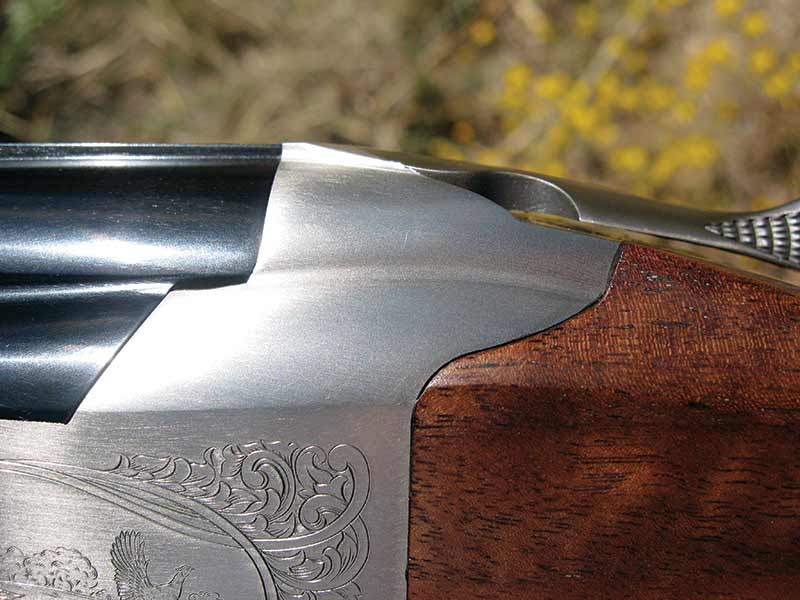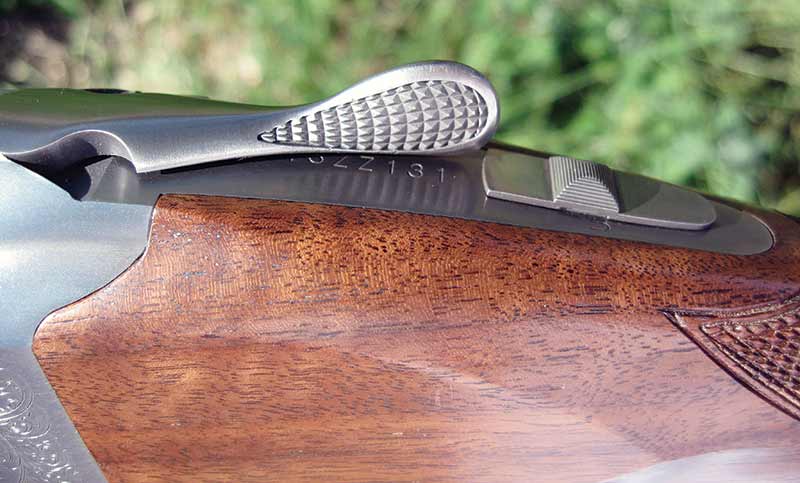23
The Browning 725
Look what they’ve done to the Citori!
Browning’s new Model 725 is not your father’s Citori. Introduced in 1972, the Citori is certainly one of the world’s most successful O/U designs, but like all good designs, it was time for a facelift. Having aged through a series of model changes starting with the Model 325 and advancing through Models 425, 525 and 625, the Citori has worn many faces with many designations and price points, ranging from plain field-grade hunting models through 4-barrel, Grade VI skeet sets. A Superposed it’s not, but the new Model 725 is certainly challenging Browning’s oldest and most famous shotgun model. In some respects, it’s even better.
Browning played it very close-to-the-chest with the redesign. It was really a tightly kept state secret until the unveiling this year. I imagine sitting down with a CAD program and beginning to redesign the flagship O/U in the Browning line was either a challenge or a moment of trepidation for the design engineer assigned to the task. The end result is a remarkable transformation of a 40-year-old design.
The most significant change in the new Citori is a completely new receiver profile. The Citori was never known for having a low-profile receiver. It does now. The height of the receiver has been reduced by 1/8″ and the top of the standing breech slimmed down and reduced in profile accordingly.
An 1/8″ doesn’t seem like much of a change, but when mated with the slimmer barrel profile of the new Citori, it changes the whole dynamic of the gun. Subtle changes to a shotgun can have dramatic results. Changes like adding a single layer of moleskin to the comb or lengthening or reducing the length of the stock by fractions of an inch or adding drop or cast-off by bending the stock or adding a ventilated rib can radically affect the way in which a gun handles and performs for its owner.
The result of giving the Citori a lower profile is that the Model 725 feels lighter and achieves that much sought after balance and weight distribution between the hands we often describe in a shotgun as being “lively.” The shallow frame of the new 725 also facilitates that ideal hands-in-line, hand-to-barrel relationship so important to accurate and intuitive shotgunning.
While Browning uses a monobloc hinge in their Cynergy model to achieve the lowest-profile receiver in the industry, the Model 725 achieves a lower profile while keeping the full- width hinge pin and tapered locking lug of the original Citori design justifiably famous for its strength and longevity. Tapering the locking lug allows the lug to compensate for wear as it occurs by progressively seating deeper in the locking recess, and, of course, a hinge pin is always replaceable. Keep the hinge pin, monobloc recess, locking lug and fore-end iron properly lubricated, and the Citori will perform perfectly through tens-of-thousands of rounds. It’s a robust design and a tough gun.
As remarkable as the new frame profile of the 725 is, the new “Fire Lite” trigger is fantastic. If I were blindfolded, handed the new Citori and pressed the trigger, I would conclude that I had been handed a Krieghoff or Perazzi match gun. Gone is the older inertia design that depended upon recoil to reset. In its place is a mechanical trigger, with a release weight of 3-1/2 to 4 pounds as measured by my Lyman electronic scale. Frankly, I was so surprised by those weight measurements I had to remeasure the trigger with a Timney mechanical scale and then even confirm my measurements with Denny Wilcox, Browning’s Product Manager. Wilcox confirmed that the factory specification is indeed 3-1/2 to 4 pounds.
Not only are the triggers sensationally light, but also there is a minimum of take-up and overtravel. The new mechanical trigger is simply the finest trigger I have ever worked with on a field-grade shotgun. “Crisp” is the word! On the sporting grade Model 725s, the trigger is setup to be adjustable for finger-to-trigger length and is available with three different, canted, trigger shoes—a wide checkered, wide smooth or narrow smooth model.
There is even a new choke tube design in the Model 725. Browning introduced their long Invector-Plus tubes years ago. The new tube for the Model 725 is named “Invector-DS,” the “DS” standing for “Double Seal.” It’s a thin-walled, flush-mounted tube in the field grade and an extended, finger-tightening tube in the sporting grades. The new Invector-DS tubes are l-o-n-g. They’re a full 3/4″ longer than the current Invector-Plus tubes. With the increased length of the new tube, Browning has been able to more gradually taper the choke and constrict the shot resulting in improved, more consistent shot patterns and slightly higher velocities.
The Invector-DS tube is threaded at the muzzle end and, where the threads are on the Plus series tube, there is an expanding, brass gas seal that compresses against the wall of the barrel as the tube is tightened. “Double Seal” it is with the brass gas seal preventing gas and fouling from wedging in between the wall of the tube and the barrel, keeping the surface of the tube cleaner and making choke tube removal much easier. The Invector-DS factory tubes are available in 7 degrees of constriction from skeet-to-full, and being thin walled, they maintain the slim, new barrel profile of the 725.
One of the less visible improvements incorporated in Model 725 is the Inflex II technology built into the recoil pad. Inside the pad are a series of ribs that flex when the shot is fired and actually lower the comb slightly away from your face during recoil. The combination of a shallower-profile receiver and the Inflex pad, work together to reduce barrel flip and moderate felt recoil. It’s a dynamic system that works.
If I sound enthusiastic about this new Citori, I am. I bought the first one I saw in Tucson, and Golden Steamer and I are chomping at the bit for the opening of the 2012 quail season. With the new Model 725 in hand, I think this may be a hunting season to remember.
MODEL 725 CITORI
MAKER:Browning (by Miroku)
One Browning Pl.
Morgan, UT 84050
(800) 333-3288
Models: Field (tested), Sporting, Adjustable Sporting, Featherweight (tba), Action: Over/under, Caliber: 12 gauge, Capacity: 2, Barrel length: 26″ or 28″ (Field), 28″, 30″ or 32″ (Sporting), Choke: Invector-DS (7), Overall length: 43-3/4″ with 26″ barrel, Weight: 7 pounds, 4 ounces, to 7 pounds, 10 ounces, Finish: Silver nitride (receiver), blue (barrels), Sights: front and mid bead, Stocks: Field: Grade ii or iii walnut, Sporting: Grade iii or iv, Drop-at-comb: 1-5/8″ (field), 1-9/16″ (Sporting), Drop-at-heel: 2-1/2″ (Field & Sporting), Length-of-pull: 14-1/4″ (Field), 14-3/4″ (Sporting), Price: $2,469 (Field), $3,139 (Sporting)







